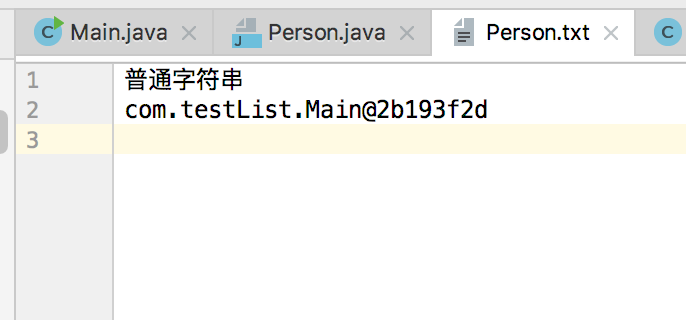廖雪峰Java6IO编程-2input和output-1inputStream
1.InputStream
1.1InputStream是所有输入流的超类:
- int read()
* 读取下一个字节,并返回字节(0-255)
* 如果已读到末尾,返回-1
* read()方法是阻塞(blocking)的,必须等待read()方法返回才能执行下一行代码 - int read(byte[]):读取若干字节并填充到byte[]数组,返回读取的字节数
- int read(byte[], int off, int len):指定byte[]数组的偏移量和最大填充术数。
- void close():关闭输入流
- 使用try(resource)可以保证InputStream正确关闭
代码一,使用close关闭文件:如果运行时发生IO错误,文件不能正确关闭,资源不能得到及时的释放
public class Main {public static void main(String[] args) throws IOException {InputStream input = new FileInputStream("./src/main/java/com/testList/Person.txt");int n;while((n=input.read())!= -1){System.out.println(n);}input.close();}}
代码二:
public class Main {public static void main(String[] args) throws IOException {InputStream input = null;try{input= new FileInputStream("./src/main/java/com/testList/Person.txt");int n;while((n=input.read())!= -1){System.out.println(n);}}finally {if (input != null) {input.close();}}}}
代码三,使用try(resource)保证InputStream正确关闭,推荐
public class Main {public static void main(String[] args) throws IOException {try(InputStream input = new FileInputStream("./src/main/java/com/testList/Person.txt")){int n;while((n=input.read())!= -1){System.out.println(n);}}//自动关闭InputStream}}
代码四,利用缓冲区一次读取多个字节
public class Main {public static void main(String[] args) throws IOException {try(InputStream input = new FileInputStream("./src/main/java/com/testList/Person.txt")){byte[] buffer = new byte[10];int n;while((n=input.read(buffer))!= -1){System.out.println(Arrays.toString(buffer));}}}}
1.2常用InputStream
1.2.1 FileInputStream
FileInputStream是InputStream的实现类,可以从文件获取输入流。
try(InputStream input = new FileInputStream("./src/main/java/com/testList/Person.txt")){byte[] buffer = new byte[10];int n;while((n=input.read(buffer))!= -1){System.out.println(Arrays.toString(buffer));}
1.2.2 ByteArrayInputStream
ByteArrayInputStream可以在内存中模拟一个InputStream。用的不多,可以测试的时候构造InputStream
public class Main {public static void main(String[] args) throws IOException {byte[] data = {-26, -103, -82, -23, -128, -102, -27, -83, -105, -25,-84, -90, -28, -72, -78, 10, 99, 111, 109, 46,116, 101, 115, 116, 76, 105, 115, 116, 46, 77,97, 105, 110, 64, 50, 98, 49, 57, 51, 102,50, 100, 10, 64, 50, 98, 49, 57, 51, 102};try(InputStream input = new ByteArrayInputStream(data)){byte[] buffer = new byte[10];int n;while((n=input.read(buffer))!= -1){System.out.println(Arrays.toString(buffer));}}}}
1.3总结:
- InputStream定义了所有输入流的超类
- FileInputStream实现了文件输入
- ByteArrayInputStream在内存中模拟一个字节流输入
- 使用try(resource)保证InputStream正确关闭
2.OutputStream
2.1 java.io.OutPutStream是所有输出流的超类:
- abstract write(int b):写入一个字节
- void write(byte[] b):写入byte数组的所有字节
- void write(byte[] b, int off, int len):写入byte[]数组指定范围的字节
- write()方法是阻塞的,必须等待write方法执行完毕返回后才能执行下一行代码
- void close():关闭输出流
- 使用try(resource)可以保证OutputStream正确关闭
- void flush() :将缓冲区的内容输出
为什么需要flush呢?
因为像磁盘、网络写入数据的时候,出于效率的考虑,很多时候,并不是输出1个字节就立即写入。而是先把输出的字节放在内存缓冲区里,等到缓冲区满了之后,再一次性写入。对于很多设备来说,一次写入1个字节和写入1000个字节话费的时间是一样的。所以Output Stream有一个flush方法,能够强制把缓冲区的内容输出。通常情况下,我们不需要调用这个方法,因为缓冲区在满的时候,会自动调用flush。我们在调用close方法关闭OutputStream时,也会调用flush方法。
代码一:如果写入过程中发生IO错误,OutputStream不能正常关闭
public class Main {public static void main(String[] args) throws IOException {OutputStream output = new FileOutputStream("./src/main/java/com/testList/output.txt");output.write(72);//1次写入1个字节output.write(101);output.write(108);output.write(108);output.write(111);output.close();}}
代码二:通过try(resource)自动关闭文件
public class Main {public static void main(String[] args) throws IOException {try(OutputStream output = new FileOutputStream("./src/main/java/com/testList/output.txt")){output.write(72);output.write(101);output.write(108);output.write(108);output.write(111);}}}
代码三:一次传入多个字节
public class Main {public static void main(String[] args) throws IOException {try(OutputStream output = new FileOutputStream("./src/main/java/com/testList/output.txt")){byte[] b = "hello,张三".getBytes("UTF-8");output.write(b,3,9);}}}
代码四:一次性写入
public class Main {public static void main(String[] args) throws IOException {try(OutputStream output = new FileOutputStream("./src/main/java/com/testList/output.txt")){byte[] b = "hello,张三".getBytes("UTF-8");output.write(b);}}}
2.2 常用OutPutStream:
2.2.1 FileOutStream
FileOutStream可以输出到文件
2.2.2 ByteArrayOutPutStream
ByteArrayOutputStream可以在内存中模拟一个OutputStream
public class Main {public static void main(String[] args) throws IOException {try(ByteArrayOutputStream output = new ByteArrayOutputStream()){output.write("Hello".getBytes("utf-8"));output.write("world!".getBytes("utf-8"));byte[] data = output.toByteArray();System.out.println(Arrays.toString(data));}}}
2.3 总结
- OutputStream定义了所有输出流的超类
- FileOutputStream实现了文件流输出
- ByteArrayOutputStream在内存中模拟一个字节流的输出
- 使用try(resource)保证OutputStream正确关闭
3.Input/OutPut练习
FileInputStream可以从文件读取数据,FileOutputStream可以把数据写入文件。
如果我们一边从一个文件读取数据,一边把数据写入到另一个文件,就完成了文件的拷贝。
请编写一个程序,接收两个命令行参数,分别表示源文件和目标文件,然后用InputSream/OutputStream把源文件复制到目标文件。
复制后,请检查源文件和目标文件是否相同(文件长度相同,内容相同),分别用文本文件、图片文件和zip文件测试。
使用FileInputStream读取文件
import java.io.File;import java.io.FileInputStream;import java.io.IOException;public class Main {public static void main(String[] args) throws IOException {File f = new File("./src/main/java/com/testList/Person.java");System.out.println(f.length());//创建字节输入流FileInputStream fis = new FileInputStream("./src/main/java/com/testList/Person.java");//创建竹筒byte[] bbuf = new byte[100];//保存实际读取的字节数int hasRead = 0;//使用循环重复取水过程while((hasRead = fis.read(bbuf))>0){//取出竹筒中的水滴即字节,将字节数组转换成字符串输入System.out.println(new String(bbuf,0,hasRead));}//关闭字节流fis.close();}}
使用FileReader读取文件
import java.io.File;import java.io.FileReader;import java.io.IOException;public class Main {public static void main(String[] args) throws IOException {File f = new File("./src/main/java/com/testList/Person.java");System.out.println(f.length());try(//创建字符输入流FileReader fr = new FileReader("./src/main/java/com/testList/Person.java")){//创建一个长度为100的竹筒char[] cbuf = new char[100];//hasRead用于保存实际读取的字符数int hasRead = 0;while((hasRead =fr.read(cbuf))>0){//使用循环重复取水过程//取出竹筒中的水滴即字符,将字符数组转换为字符串输入System.out.println(new String(cbuf,0,hasRead));}}catch (IOException ex){ex.printStackTrace();}}}
import java.io.*;public class Main {public static void main(String[] args) throws IOException {try(//创建字节输入流FileInputStream fis = new FileInputStream("./src/main/java/com/testList/Person.java");//创建字节输出流FileOutputStream fos = new FileOutputStream("./src/main/java/com/testList/Person.txt")){byte[] bbuf = new byte[300];int hasRead = 0;//循环从输入流中取出数据while ((hasRead = fis.read(bbuf))>0){//取出1次,写入1次fos.write(bbuf,0,hasRead);}}catch (IOException ex){ex.printStackTrace();}}}
import java.io.*;public class Main {public static void main(String[] args) throws IOException {try(//创建字节输出流FileWriter fw = new FileWriter("./src/main/java/com/testList/Person.txt")){fw.write("于易水送人 - 骆宾王\r\n");fw.write("此地别燕丹,壮士发冲冠。\r\n");fw.write("昔时人已没,今日水犹寒。\r\n");}catch (IOException ex){ex.printStackTrace();}}}
import java.io.*;public class Main {public static void main(String[] args) throws IOException {try(FileOutputStream fos = new FileOutputStream("./src/main/java/com/testList/Person.txt");PrintStream ps = new PrintStream(fos)){ps.println("普通字符串");ps.println(new Main());}catch (IOException ex){ex.printStackTrace();}}}

廖雪峰Java6IO编程-2input和output-1inputStream的更多相关文章
- 廖雪峰Java6IO编程-1IO基础-1IO简介
1.IO简介 IO是指Input/Output,即输入和输出: Input指从外部读取数据到内存,例如从磁盘读取,从网络读取. * 为什么要把数据读到内存才能处理这些数据呢? * 因为代码是在内存中运 ...
- 廖雪峰Java15JDBC编程-3JDBC接口-5JDBC连接池
1. JDBC连接池 1.1 JDBC连接池简介 线程池可以复用一个线程,这样大量的小任务通过线程池的线程执行,就可以避免反复创建线程带来的开销. 同样JDBC可以复用一个JDBC连接 JDBC的连接 ...
- 廖雪峰Java15JDBC编程-3JDBC接口-4JDBC事务
1 数据库事务:Transaction 1.1 定义 若干SQL语句构成的一个操作序列 要么全部执行成功 要么全部执行不成功 1.2 数据库事务具有ACID特性: Atomicity:原子性 一个事务 ...
- 廖雪峰Java15JDBC编程-3JDBC接口-3JDBC更新
使用update语句的时候,需要通过JDBC实现update语句的执行,这个时候仍然通过PreparedStatement对象来使用,直接传入update语句,然后通过setObject传入占位符的值 ...
- 廖雪峰Java15JDBC编程-3JDBC接口-2JDBC查询
我们可以使用JDBC查询来执行select语句. 1. Statement try(Connection conn = DriverManager.getConnection(JDBC_URL, JD ...
- 廖雪峰Java15JDBC编程-3JDBC接口-1JDBC简介
JDBC:Java DataBase Connectivity Java程序访问数据库的标准接口 使用Java程序访问数据库的时候,Java代码并不是直接通过TCP连接去访问数据库,而是通过JDBC接 ...
- 廖雪峰Java15JDBC编程-2SQL入门-2insert/select/update/delete
1. INSERT用于向数据库的表中插入1条记录 insert into 表名 (字段1,字段2,...) values (数据1,数据2,数据3...) 示例 -- 如果表存在,就删除 drop t ...
- 廖雪峰Java15JDBC编程-2SQL入门-1SQL介绍
1.SQL:结构化查询语言 Structured Query Language 针对关系数据库设计 各种数据库基本一致 允许用户通过SQL查询数据而不关心数据库底层存储结构 1.1 SQL使用: 可以 ...
- 廖雪峰Java15JDBC编程-1关系数据库基础-1关系数据库简介
1.数据库 1.1 定义 数据库是按照数据结构来组合.存储和管理数据的软件. 1.2 数据库模型 数据库有层次模型.网状模型.关系模型三种模型. 2 关系数据库 关系数据库是建立在关系模型上的数据库, ...
随机推荐
- mvc core2.1 Identity.EntityFramework Core 登录 (三)
Controllers->AccountController.cs 新建 [HttpGet] [AllowAnonymous] public async Task<IActionResul ...
- (1)HTML的组成(什么是标签、指令、转义字符、数据、标签字符表)
html的组成:标签+指令+转义字符+数据 1.标签 <>内的,以字母开头,可以结合合法字符(- 或者数字),能被浏览器解析的符号 <!DOCTYPE html> #这个是系统 ...
- maven 总结整理(二)——download source code
当我们用maven下载jar包时,有时希望下载jar包的源代码,此时可以在pom.xml文件中,进行设置. <build> <finalName>WebProject&l ...
- 数学的语言 化无形为可见 (Keith Devlin 著)
第一章 数字为何靠的住 (已看) 第二章 心智的模式 (已看) 第三章 动静有数 (已看) 第四章 当数学成型 (已看) 第五章 数学揭开美之本质 (已看) 第六章 当数学到位 (已看) 第七章 数学 ...
- 微软Azure通知中心 (Azure Notification Hubs)
Azure Notification Hubs 提供简单的方法从后台(azure或者on-promise)去发送通知在不同的平台上面(iOS, Android, Windows, Kindle, Ba ...
- React Native 学习资料
React Native 学习资料 学习资料 网址 React Native中文网 https://reactnative.cn/
- 单页面应用(SPA)重新部署后,正在浏览的页面如何更新缓存?
当单页面的系统在重新部署更新时,此时正在浏览网页,并且已经在网页内的用户,始终会使用老的js与css文件,一直在使用已经缓存了的静态资源. 所有的缓存问题焦点都在index.html上,只要index ...
- 说明os,sys模块不同?并列举常用的模块方法
官方解释: os: This module provides a portable way of usingoperating system dependent functionality. 翻译:提 ...
- Linux 命令之删除命令
在Linux下删除文件用rm命令,具体用法如下: rm [选项] 文件 选项说明: -f -force 忽略不存在的文件,强制删除,无任何提示 -i --interactive 进行交互式地删除 -r ...
- 解决Ecipse和搜狗输入法快捷键冲突问题
非常简单,关闭掉搜狗输入的所有快捷键!
